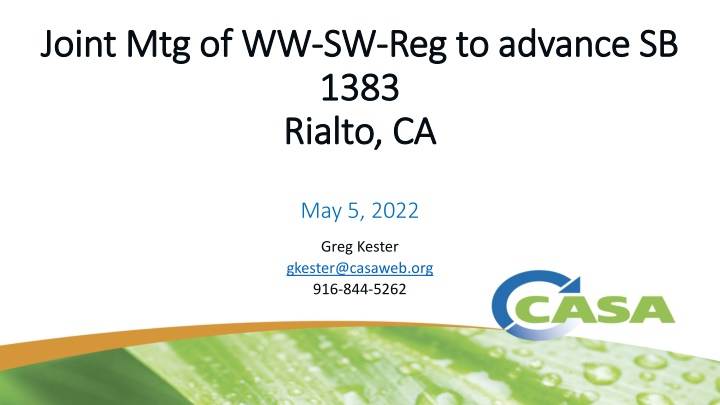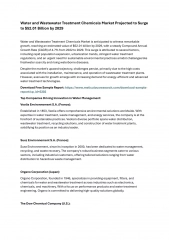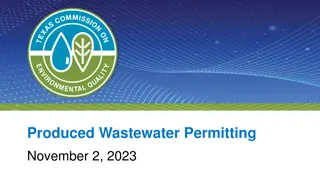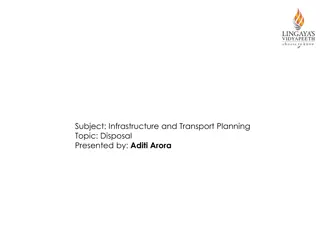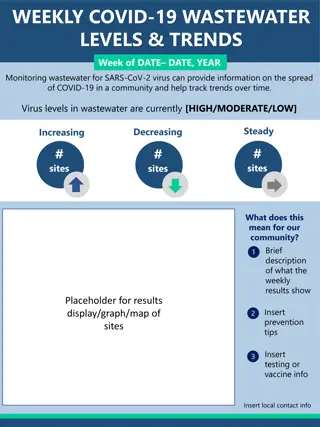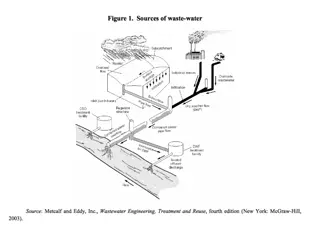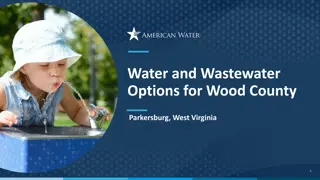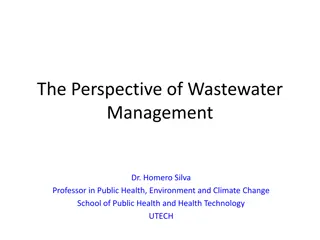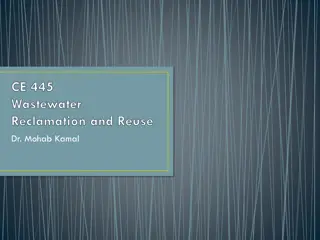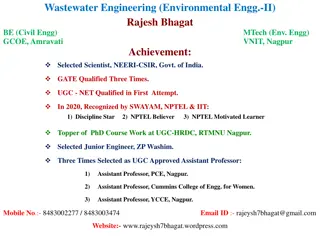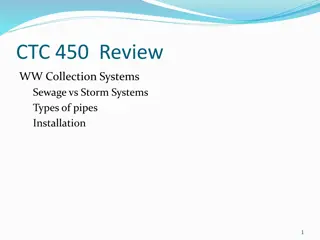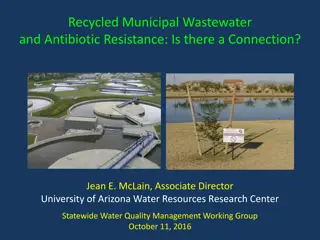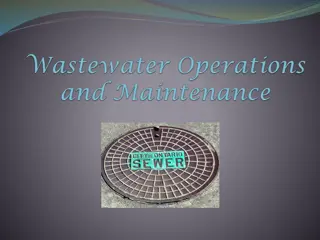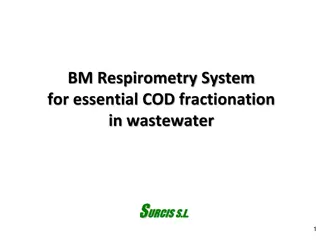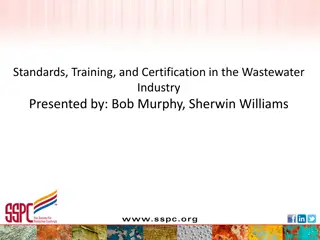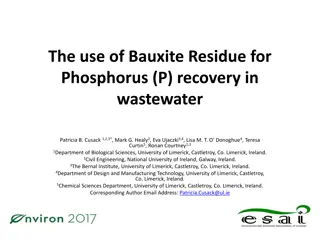Advancing SB 1383 Objectives through Wastewater Sector Collaboration
The Wastewater Sector plays a crucial role in achieving California's SB 1383 objectives by implementing regulations that focus on reducing methane emissions, diverting organics from landfills, and promoting beneficial use of biosolids. Collaborative efforts within the sector can lead to increased biogas production for renewable energy and transportation fuel, while also contributing to carbon sequestration and reducing greenhouse gas emissions. Explore the opportunities presented by the sector to meet sustainable goals effectively.
Download Presentation

Please find below an Image/Link to download the presentation.
The content on the website is provided AS IS for your information and personal use only. It may not be sold, licensed, or shared on other websites without obtaining consent from the author.If you encounter any issues during the download, it is possible that the publisher has removed the file from their server.
You are allowed to download the files provided on this website for personal or commercial use, subject to the condition that they are used lawfully. All files are the property of their respective owners.
The content on the website is provided AS IS for your information and personal use only. It may not be sold, licensed, or shared on other websites without obtaining consent from the author.
E N D
Presentation Transcript
Joint Mtg of WW Joint Mtg of WW- -SW SW- -Reg to advance SB Reg to advance SB 1383 1383 Rialto, CA Rialto, CA May 5, 2022 Greg Kester gkester@casaweb.org 916-844-5262
CA Legislation to Mitigate Climate Change CA Legislation to Mitigate Climate Change Achieve 40% reduction in GHG emissions below 1990 levels by 2030 and Carbon Neutrality by 2045 100% Clean/Renewable Electrical Energy by 2045 (with 50% by 2026 and 60% by 2030) 20% reduction in Carbon Intensity of transportation fuel by 2030 Short-Lived Climate Pollutant Reduction 40% methane reduction by 2030 from 2013 (through SB 1383 implementation) Healthy Soils Initiative, Natural & Working Lands Climate Smart Strategy, and Wildfire & Forest Resilience Action Plan 2
SB 1383 Adopted in 2016 Regulations Approved in 2020 Reduce Short-Lived Climate Pollutants Legislation Adopted in 2016 and requires 40% reduction in methane emissions with 2013 as the baseline by 2030 75% organics diversion from landfills (including biosolids) relative to 2014 levels by 2025 3
SB 1383 Implementation We believe the state recognizes that Wastewater Sector is key to successful implementation To that end, two incentives were included in regulations intended to create markets Disallow local ordinances that unreasonably restrict or prohibit land application of biosolids Every jurisdiction required to divert organic waste must then procure a product of that diversion compost and/or beneficial use of biogas 4
Opportunities Offered by the Wastewater Sector to Meet SB 1383 Objectives via Co-Digestion Use of existing infrastructure to accept at least 75% of food waste currently landfilled for anaerobic digestion Increase biogas production to generate renewable energy, low carbon transportation fuel, and pipeline grade RNG, in turn decreasing greenhouse gas emissions Build healthy soils, sequester carbon, and reduce fossil fuel based inorganic fertilizer use through land application of biosolids Develop collaborative partnerships with private sector
Co-digestion Accelerates Diversion of Organics from Landfills Opportunity: ~150 wastewater plants already utilize anaerobic digestion and have excess capacity - ~ 90+% of wastewater flow Plants are often located in urban areas near waste generation > shorter haul Challenges/Needs: Must build partnerships with solid waste sector to maximize effective diversion Cleanliness of organic waste stream must be assured (whether for co- digestion, digestion, or compost) Markets must be assured for both biogas and biosolids
Significant Additional Renewable Energy Potential Significant Additional Renewable Energy Potential If co-digestion is maximized to utilize all existing capacity and 3.4 million tons of food waste is accepted for co-digestion we can increase energy by: 822,800 MegaWatt hours 7.5 million MBTu s 71.4 Million Diesel Gallon Equivalents transportation fuel when combined with what is produced from sewage sludge digestion - would allow 575 million miles to be driven by Heavy Duty Trucks with Renewable Fuel Working with CARB to ensure heavy duty trucks, vactor trucks, etc. can continue to use our RNG! Electric options don t exist yet and won t for some time 7
Further Opportunities for the Water Sector Further Opportunities for the Water Sector CPUC on 2/24 adopted a decision to require Investor Owned Utilities (IOUs) to procure biomethane via pipeline injection POTWs who co-digest will be given priority as targeted customers ------ CEC contacted CASA to see how the water sector might help address potential energy shortfall Working with them on opportunities to go off grid during peak demand via storage reservoir pumping shifts, co-gen, & battery storage operational changes and worker schedule shifts possible 8
Further Opportunities for the Water Sector Further Opportunities for the Water Sector Need capital, tariff changes, policy shifts, regulatory relief to execute Positive work continues with Vice Chair Gunda, Commissioner Douglas and their teams ----- Working with CNRA to include biosolids land application in the Natural and Working Lands program 9
California Biosolids Management in 2020 California Biosolids Management in 2020 Deep Well Injection, 1% Total Generated: 658,000 Dry Metric Tons (DMT) Land Application: 441,000 Landfill: 150,000 74,000 ADC 76,000 Burial Incinerate: 15,000 Surface Disposal: 20,000 Deep Well Injection: 9,000 Storage, long-term treatment: 23,000 Storage, 3% Surface Disposal, 3% Incineration, 2% Landfill Disposal, 12% Landfill ADC, 11% Land Application, 67%
Biosolids Challenges in California Rural/Urban disparity most production in coastal urban centers, largest need in Central Valley and other rural agricultural centers Poor management (refusal to fix roads, be good neighbors, etc.) and oversight in early 1990 s resulted in restrictive ordinances both are no longer an issue and no new ordinances since 2007 Kern and Imperial County Prohibitive ordinances were challenged in court and overturned SB 1383 regulations disallow restrictive or prohibitive ordinances on biosolids land application CalRecycle has been very collaborative and are working to educate counties with such ordinances 11
Biosolids Challenges in California Very limited options for renewable resource which will increase as long as society exists Incineration (only 1 and do not expect any more in CA) Surface Disposal (only 5 and do not expect any more) Alternative Daily Cover or disposal in Landfills (98 send at least some for this purpose but ~0 as of 2025) LAND APPLICATION Best sustainable option in long-term 12
Biosolids Land Application in California - 2020 DEL NORTE NORTE DEL SISKIYOU MODOC SHASTA LASSEN HUMBOLDT TEHAMA PLUMAS County Ordinance Requirements and Biosolids Bans GLENN BUTTE SIERRA NEVADA PLACER COLUSA MENDOCINO LAKE EL DORADO YOLO NAPA ALPINE SOLANO MARINCONTRA COSTA SAN TUOLUMNE JOAQUIN SAN FRANCISCO ALAMEDA S F SAN MATEO Ban on All Land Application SANTA CLARA INYO Ban on Class B SAN BENITO TULARE Conditional Use Permit Required SAN LUIS OBISPO KERN Class B Land Application Allowed SAN BERNARDINO SANTA BARBARA LOS No Regulations/Ordinances Enacted VENTURA ANGELES RIVERSIDE AZ ORANGE SAN DIEGO IMPERIAL This map is based on a search of online available Codes and may have missed County other requirements such as non-codified requirements or requirements of city or regional agencies. This map presents findings for individual county requirements and deals only with the unincorporated areas of the counties, all area in California are subject to California and Federal biosolids regulations.
Biosolids Regulatory Foundation USEPA adopted risk based federal standards for the use of biosolids in 1993 (40 CFR part 503) replaced 40 CFR part 257 (which still regulates industrial residuals) Biennial review required by CWA which has been done since 2003 SWRCB adopted Programmatic EIR and General Order in 2004 Biosolids are dually regulated by USEPA and SWRCB Both regulatory frameworks promote the land application of biosolids Two reviews by the NAS have supported the US regulations and land app 14
Biosolids Regulatory Foundation Regulation of biosolids is dynamic and must remain based on sound science This is true for any regulation designed to protect public health and the environment and has been for biosolids since the CWA was adopted An overarching finding of the NAS Committee in 2002, on which I served, was to continually pursue research not because one would expect to find adverse impacts, but because it s the responsible course of action When evaluating new constituents, it is important to consider practical experience based on decades of land application and net environmental impacts 15
Recommended Changes to Biosolids General Order Recommended Changes to Biosolids General Order Remove ability for local jurisdictions to be more restrictive Do not use background soil concentrations as part of the cumulative soil limit since they were included in the risk assessment Adopt the federal restriction for animal grazing after application (30 days) Do not apply the GO to exceptional quality biosolids Delete remanded limit for Molybdenum 16
LOCAL PROBLEM SOLVED BY LOCAL STUDY January 2020 Pima County (Tuscon, AZ) Board of Supervisors impose moratorium on land application in Pima County March October 2020 University of Arizona Water and Environmental Technology Center (WET) in collaboration with Pima County Wastewater evaluate incidence and transport of PFAS following long-term land application (since 1984) Data showed low incidence of soil PFAS and limited mobility of PFAS through soil and vadose zone Data presented to Pima County Administrator December 2020, moratorium rescinded FOR A NATIONAL PROBLEM WE NEED A NATIONAL STUDY
EVALUATION OF FATE AND TRANSPORT OF PFAS FOLLOWING LONG-TERM LAND APPLICATION: A COLLABORATIVE NATIONAL STUDY Principal Investigator: Ian Pepper University of Arizona Co-Principal Investigators: Mark Brusseau University of Arizona Greg Kester California Association of Sanitation Agencies Jeff Prevatt Pima County Wastewater
NATIONAL COLLABORATIVE PROJECT OVERALL PROJECT GOAL To evaluate whether or not land application of biosolids is a significant public health route of exposure to perfluorinated compounds (PFAS) Specific Objectives: Evaluate - Incidence of PFAS analytes in soil following long-term land application of biosolids - Mobility (leaching) of PFAS analytes through soil and vadose zone under the influence of rainfall and/or irrigation - Crop uptake of PFAS analytes
Research and Safe Practices of Biosolids Research and Safe Practices of Biosolids Not One Documented Adverse Effect of Biosolids Application Over Decades Research has Been Done Over the Past 70 Years with Universal Support of Land Application as the most Sustainable and Beneficial Use Research and Risk Assessment Continue for Emerging Contaminants of Concern EPA Recently Updated its Biosolids Screening and Full Risk Assessment Models Science Advisory Board is reviewing them and convened an expert Biosolids panel, to which I have been appointed 20
We are public agencies that work to serve the public good California agencies follow all existing regulations. Research and experience have demonstrated numerous benefits from using biosolids. There has not been any documented negative impacts to human health from the use of biosolids as a fertilizer. Our agencies are eager to work with regulators to answer any questions they have with research studies led by independent University of California researchers or other academic institutions.
Questions? Greg Kester CASA Director of Renewable Resource Programs gkester@casaweb.org 916-844-5262
